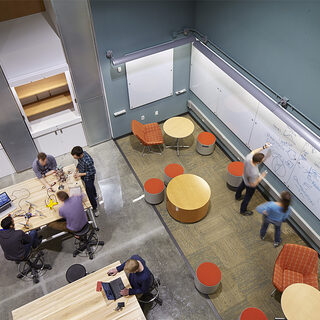Tradeline's industry reports are a must-read resource for those involved in facilities planning and management. Reports include management case studies, current and in-depth project profiles, and editorials on the latest facilities management issues.
Latest Reports
New Jersey Institute for Food, Nutrition and Health
The 80,000-sf, three-story New Jersey Institute for Food, Nutrition and Health (IFNH), on the George H. Cook Campus of Rutgers University, is dedicated to promoting a healthy lifestyle statewide, and serves as a national model of interdisciplinary research and public health practice, with research laboratories and core facilities, laboratory support, a preschool, office space, team rooms, and a food service area.
Evolving Pedagogies Drive STEM Facility Design
An increased focus on creating active, engaging, and collaborative learning environments for STEM disciplines is changing the way these spaces are planned and designed, while demands for sustainability and space and energy efficiencies continue to exert an influence. The expansion of the traditional science, technology, engineering, and mathematics acronym to include art (STEAM); science, math, and art (SMArt); or nursing (SMArt Nursing) is driving new classroom and laboratory configurations and more inviting, open designs, where learning is on full display.
The Foundry, a Maker Space at Duke University
At Duke University, a new 7,600-sf maker space is generating substantial excitement among students and faculty alike. An older building, Gross Hall, was completely renovated. Prior to the renovation, the basement level housed air handlers and other outdated utility equipment; with its expansive floorplate and 35-foot ceiling freed up, the design team was able, over the course of a year, to create a comprehensive, co-curricular space for projects of all kinds.
Intel Designs Next Generation Workplace for Recruitment and Retention
Even with large expanses of cubicles, the workplace environment at Intel’s new RA4, a seven-story office/factory building in Hillsboro, Ore., sports a fresh, contemporary look carefully calibrated to support the recruitment and retention of top employee talent. A combination of collaboration spaces and amenities, such as a 36,000-sf cafeteria that offers half a dozen different types of cuisine, along with an abundance of natural light and outdoor views, has produced a building that earns approval across the four employee generations that occupy the facility.
The Pirbright Institute’s Plowright Building Transforms the High Containment Lab by Inverting Traditional Models
The Pirbright Institute’s Plowright Building represents a visionary new model for biocontainment lab design that includes offices, conference areas, an atrium, and a cafeteria all within the containment zone, so researchers don’t need to shower in and out multiple times a day. This inverts the traditional approach to biocontainment design by putting people at the center and lab spaces at the perimeter. Researchers enter the building starting in a centralized non-containment zone and work their way toward the perimeter throughout the day, in a one-way flow.





